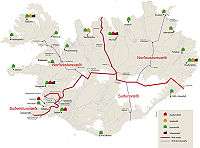Icelandic Road Administration
The Road and Coastal Administration (Icelandic: Vegagerðin) is a state run institution in Iceland whose purpose is to construct and maintain roads and infrastructure (land and sea) in rural areas and between urban areas. It belongs to the Ministry of the Interior and is the legal owner of the roads and has the authority to execute construction of infrastructures on demand from the ministry.
| Vegagerðin | |
 Logo of Road Administration | |
| Agency overview | |
|---|---|
| Jurisdiction | Iceland |
| Headquarters | Reykjavík, Iceland |
| Employees | 311 |
| Minister responsible | |
| Agency executive |
|
| Website | road vegagerdin |
History
Until the 20th century
Until the 18th century there were no official roads in Iceland, only paths and barely visible tracks which people followed with the help of cairns for a few kilometers in either direction. In the 19th century, when fishing villages began to spring up on shores and sandbanks, infrastructure between farms and villages began to improve. As fishermen's camps became villages, with homes and workshops, they also became important trading posts for the farms around them. Farmers traveled to the villages with their raw materials and traded these for imported goods, mostly Danes. This was, of course, not a new thing in Iceland. These places had long been sites for Danish tradesmen but as these trading posts became villages, communication and infrastructure were bound to improve due to increased traffic. In the 19th century, horse carriages became more common among farmers and by the beginning of the 20th century carriage trail tracks had formed from every village in the countryside.
Early 20th century – 1960
In the early 20th century a few automobiles had come to Iceland and streets had been formed in the largest towns. But roads were needed to connect settlements, and the government called for the old horse tracks to be upgraded to gravel roads. In 1918 the Icelandic government established the offices of Vegamálastjóri (Director of Roads) and Vitamálastjóri (Director of Lighthouses). The latter was an officer overseeing lighthouses and sea transportation and the office of Vegamálastjóri was the predecessor of the Vegagerð Ríkisins institution which was formed a few years later and is now called Vegagerðin. The history of road construction in Iceland can be divided into two eras: pre-1960 and post-1960. Before 1960 the main concern of the government was to provide road access to all populated areas and to all farms. This was a great task and there was a modest budget. The roads were built by a large human workforce and they were narrow and uneven. The terrain was challenging for the roadbuilders as it is often rough, and most places in the Eastern and Westfjords are surrounded by dominating cliff mountains and headlands.
1960–present
Iceland became very wealthy after World War II via the Marshall Plan, and in the 1950s and 1960s enormous progress was made in Icelandic infrastructure. In 1960 it was announced that the task of giving all populated areas road access was completed; the next step was to improve these wretched roads, to build bridges and tunnel and to improve road surfaces using asphalt. At the time, Vegagerðin was a very large organization in proportion to Iceland's population, with many workers and much equipment. In the 1980s and 1990s, when the huge wave of privatisation in Iceland and Western Europe, independent contractors became more common in road construction, both in urban and rural areas. Vegagerðin reduced its direct labour workforce and began to rely more and more on private contractors for building roads and other infrastructure.
Today Vegagerðin has no road building workforce or equipment: the work has been completely privatized. Thus Vegagerðin is the intermediary between the contractors and the government. Although the word vegagerðin means "the road-makers", it is now an administrative organisation which employs mainly office staff, doing measuring, planning and tendering.
Road administration areas

Vegagerðin has its headquarters in the capital, Reykjavík, but its activity in the countryside is controlled from outposts in various towns and the country is divided into four administrative divisions. Those are South, Southwest, Northwest and Northeast. Each of these is subdivided into two service areas, except for the Southwest area which covers only a small area. That is because it includes the capital, and has a much denser road network than the other regions. The service area is where the maintenance department of each service facility (which are in various towns and villages) can maintain the road, signs, tunnels etc.
External links
- Official website (in English)
- Official website (in Icelandic)